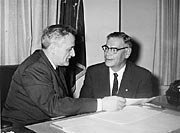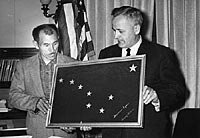Governing Alaska
Alaska entered the union with a rush of civic pride. Tom Stewart of Juneau, who had served as secretary of the constitutional convention, said the central meaning of statehood was the "achievement of full self-government, in its unique American form."
The governmental framework had been created three years earlier when the 55 delegates wrote the Alaska Constitution in Fairbanks. The document was fairly short, as constitutions go, giving a lot of authority to the legislature and the executive branch. Alaskans had ratified the constitution on April 24, 1956.
The constitution gave flexibility to the new government to find creative ways to solve its problems. The constitution can be thought of as a government outline. The legislature had the task of developing laws to guide day-to-day operations. Constitutional historian Gordon Harrison wrote that the blueprint shows confidence in the legislature, and allows elected representatives broad discretion in deciding how the government should be run.
The constitution sets up three branches of government, the same as on the federal level. The legislative branch writes laws, the executive branch is assigned to carry them out, and the judicial branch is ordered to interpret the work of the other two.
Having three branches of government allows for "checks and balances" and is founded on the idea of the "separation of powers," meaning that each branch has a specific job to do. There are systems in place so that no one of the three branches has absolute power and each has some way of keeping the others in check. For instance, the governor can veto acts of the legislature, and the legislature can override a veto if it chooses. When laws are challenged in court, the Alaska Supreme Court decides if the measures comply with the constitution.The executive branch is headed by the governor, who is elected every four years.
The legislature is made up of a 20-member senate and 40-member house. The constitution created a unified court system so that the various levels of the judiciary branch would not be fragmented.
The new, strong legislative and executive branches were in contrast to the weak system during territorial days, when the governor and the legislature worked in the shadows of federal agencies in Washington D.C.
The Alaska constitution can be changed or amended through a two-step process. First, the legislature must approve an amendment with a two-thirds vote in each house. Then, the voters must approve the change at the next general election. General elections are held in November of even-numbered years.
The Alaska constitution has been amended 27 times. Alabama, by contrast, has amended its constitution, ( more than 10 times longer than Alaska's) nearly 750 times over the past century.
A second way of amending the Alaska constitution is through another constitutional convention, which can be called by the legislature or the voters. At least once every ten years, the state asks voters if they want to hold another constitutional convention. Most recently, in 2002, the voters said "no".
Links:
- Overview of governments in Alaska
- Amendments to the state constitution
- Letter by President Eisenhower on presenting the first 49-star flag to Alaska.
- President Eisenhower's remarks on first visit after statehood
- Comments by Lyndon Johnson on what he said was last transition step to statehood

